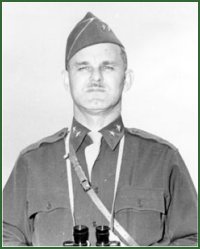William Livesay commanded the 91st Infantry Division in World War 2. He was a veteran of WW1; WW2 and Korea.
FROM FIND A GRAVE:
William G. Livesay was born in Illinois, March 2, 1895. He began his military career as a private when he enlisted in the Regular Army on May 3, 1915.
He served as a private and a corporal with the 19th Infantry, and as a corporal and sergeant clerk, Quartermaster Corps, 1915 to 1916. He received his commission as a second lieutenant of Infantry, November 26, 1916 and, on the same date, was promoted to first lieutenant.
As an enlisted man he served with the 19th Infantry on the Mexican border and later with the Quartermaster Corps at Brownsville, Texas. After receiving his commission, he attended the First Officers Class, Fort Leavenworth, Kansas from January to March 1917, and was then assigned to and served with the 30th Infantry until June 1917.
Landing with the fist contingent in France in June 1917 - now assigned to the 28th Infantry, 1st Division - he served continuously with that division in France and in the occupation of Germany until August 1, 1919. He participated in the following engagements: Sommerville, Ansuaville, Cantigny, Soissons, Saizerais, St. Mihiel, Meuse-Argonne and Sedan.
He returned to the United States in August 1919 and assigned to the 2nd Infantry he served at Camp Dadge, Iowa and Camp Sherman, Ohio. In 1920 he was assigned as an instructor at the Infantry School, Fort Benning, Georgia. In 1922 he attended the advanced class of the Infantry School. In July 1923 he was assigned to the 17th Infantry at Fort Crook, Nebraska. He attended the 1925-26 the Command and General Staff School at Fort Levenworth, Kansas. Upon graduating from this course he was then returned to the Infantry School as an instructor in June 1926.
Four years later - in June 1930 - he was assigned to the 7th Infantry, Vancouver Barracks. During 1932-33 he attended the Army War College, and in June 1933 was assigned to the Infantry Board, Fort Benning, Georgia.
In the fall of 1936, assigned to the Office, Chief of Infantry, he served one year in the training section and three years as Chief of the Training Section, Office, Chief of Infantry. In July 1940 he was assigned to command the First Battalion, 38th Infantry, at Fort Sill, Oklahoma, Infantry Demonstration Battalion, at the Field Artillery School.
January 1, 1941 to July 27, 1941 he was a member of the General Staff Corps as Assistant Chief of Staff, G-3, 2nd Division.
In July 1941 he was transferred to Puerto Rico as Chief of Staff of the Puerto Rican Department. When Congress confirmed his nomination to brigadier general, April 1942, he returned to the continental United States as Assistant Division Commander, 35th Division. In July 1942 he returned to Puerto Rico as Commander of the Puerto Rican Mobile Force.
In July 1943 he was assigned to command the 91st Infantry Division, known as the "Powder River Division" at Camp Adair, Oregon. He went overseas with that division in May 1944. The first elements of the division entered combat in the Anzio beachhead in Italy.
The division fought 160 offensive miles across mountains, rivers and plains playing a leading role in the final destruction of the German armies in Italy. In 271 combat days the division scored several "firsts" -the Arno River, Leghorn and Oisa; it secured Futa Pass, the toughest single position in the Gothic Line, Monticelli and Mt. Adone and many other enemy strongholds. The division spearheaded the drive into Bologna. The 3rd Battalion, 36th Infantry, and the 363rd Infantry Regiment, received the Distinguished Unit Citations for heroic battle achievements at Levergnano and Monticelli respectively.
General Livesay returned to the United States with the 91st Division and remained with that organization until its deactivation on December 1, 1945. He was then assigned as a member of the Military Education Board, Fort Leavenworth, Kansas. On February 7, 1946 he assumed command of the Seventh Service Command with the headquarters at Omaha, Nebraska.
Upon the deactivation of the Seventh Service Command Headquarters in May 1947, General Livesay was ordered to fort Jackson, South Carolina, where he became Commanding General of the Replacement Training Center.
In early June 1947, General Livesay was assigned as Chief of the United States Advisory Group to Greece in connection with the aid program for that country. H arrived in Greece June 19, 1947. His assignment was a Commanding General of the United States Army Group Greece (USAGG). He was appointed Director of Joint U.S. Military Advisory and Planning Group, in addition to other duties, on December 30, 1947. He headed the Army, Navy, and Air Force Officers in furnishing operational advice to the Greek Armed Forces. He was appointed as a permanent Major General on January 24, 1948. He was assigned to AGO casuals Washington, D.C. on March 5, 1948. He became Commanding General of the Armored Center and Commandant of the Armored School, at Fort Knox, Kentucky, on June 14, 1948.

PRIVATE CITIZENS SUPPORTING AMERICA'S HERITAGE
American
War Memorials Overseas, Inc.
War Memorials Overseas, Inc.
Livesay William G
Name:
William G Livesay
Rank:
Major General
Serial Number:
Unit:
91st Infantry Division
Date of Death:
1979-06-06
State:
Illinois
Cemetery:
Fort Sam Houston National Cemetery, San Antonio, Texas
Plot:
3, 181
Row:
Grave:
Decoration:
Comments:
